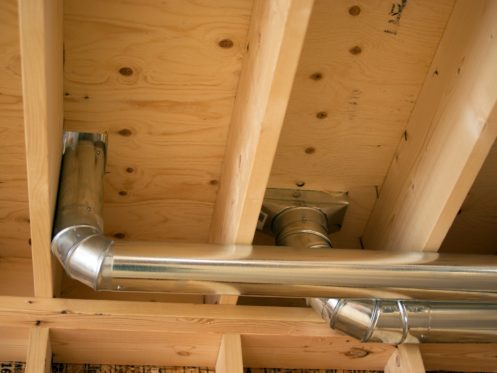HVAC systems are vital in regulating the temperature and air quality in buildings. In order to function properly, HVAC systems rely on several different types of pressure. One of these is static pressure, which is created by the resistance to airflow within the ductwork. Static pressure can have a significant impact on the performance of an HVAC system, so it is important to understand how it works. Read on to learn what static pressure is and everything in between.
Understand What Static Pressure Is
Static pressure is the force that is exerted by a fluid at equilibrium on a surface that is perpendicular to the direction of flow. The static pressure of a gas or liquid is usually measured in terms of its absolute value. In HVAC, static pressure is important because it helps to determine the amount of air that can be moved through a system. The higher the static pressure, the more air that can be moved. Static pressure is created by the resistance of the air to flow. This resistance can be due to the air’s density, the size of the ducts, or the speed of the airflow. In order to ensure that an HVAC system is operating properly, it is important to maintain the correct static pressure.
What Is a Good Static Pressure
Static pressure is measured in units of inches of water column (in WC). The amount of static pressure that is needed will vary depending on the type of system that is being used. For example, a central air conditioning system will require more static pressure than a window unit. In general, however, good static pressure for an HVAC system should be 0.5 inches of water column. This range will ensure that the airflow is sufficient for most spaces and will help to prevent problems such as drafts or reduced efficiency.
What Causes Static Pressure
There are three primary causes of static pressure in HVAC systems.
1. Clogged or Too Restrictive Air Filters
If the filters are not changed regularly, they can become clogged with dust, dirt, and other airborne particles. This can restrict airflow and cause the system to work harder to maintain the correct pressure. As a result, the system will use more energy and may eventually break down. To avoid this, it is important to change air filters regularly and to check them for signs of wear and tear. Additionally, if the filters are too restrictive, they can also cause static pressure problems. In this case, it is best to consult with a professional to determine the best way to improve airflow while maintaining system efficiency.
2. Undersized Air Returns
If the air return vents are undersized, it can cause static pressure to build up in the system. This can lead to a number of problems, including reduced airflow, increased energy costs, and decreased comfort levels. In order to ensure that your HVAC system is operating at peak efficiency, it is important to make sure that the air return vents are the proper size. If you are unsure about what size vents you need, consult a professional HVAC contractor.
3. Dirty or Too Small Indoor Coil
When your indoor coil becomes dirty or is too small, static pressure in your HVAC system can increase. This can cause your system to work less efficiently and may even cause it to break down completely. Fortunately, there are ways to prevent this from happening. First, make sure that you regularly clean your indoor coil. This will help to remove any build-up of dirt and debris that can contribute to static pressure. Additionally, keep an eye on the size of your indoor coil. If it begins to shrink, it could be a sign that static pressure is starting to build up. You can also replace the coil with a larger one if needed. If you’re not comfortable doing this yourself, we highly recommend calling a professional.
4. Poor Duct design
The design of a duct system has a significant impact on the static pressure within the system. If the ducts are poorly designed, the static pressure will be too high. There are several factors that can contribute to poor duct design, including inefficient bends, insufficient insulation, and improper sizing. By ensuring that the ducts are designed properly, it is possible to minimize static pressure and maximize airflow.
What Happens If Static Pressure Is too Low
If the static pressure in your HVAC system is too low, a number of problems can occur. One is that your system will have to work harder to move air through the ducts, which can lead to increased energy costs. In addition, your system may not be able to effectively circulate air throughout your home, leading to uneven temperatures. Low static pressure can also cause your system to overheat, which can damage major components.
What Happens If Static Pressure Is Too High
Too high static pressure in your HVAC system can cause a number of problems. For one, it can make your system work harder than it needs to, leading to increased energy costs. Additionally, high static pressure can cause air leaks in your ductwork, leading to reduced efficiency and decreased indoor air quality. Finally, high static pressure can put stress on sensitive components in your HVAC system, leading to premature failure. If you suspect that the static pressure in your HVAC system is too high, it’s important to have a professional take a look. They can diagnose the problem and recommend the best course of action to get your system back on track.
What Is Static Pressure Formula
The static pressure formula is P = FA, where P is the static pressure, F is the fluid’s force, and A is the area. The static pressure formula can be used to calculate the static pressure in several situations. For example, it can be used to determine the static pressure in a pipe with a given diameter and length. It can also be used to calculate the static pressure in a closed container, such as a tank or a vessel, or the force exerted by a fluid on a moving object, such as a car or airplane.
What Measures Static Pressure
The SI unit for static pressure is the pascal, which is equivalent to one newton per square meter. Static pressure is usually measured with a manometer, which consists of a long, U-shaped tube filled with liquid. One end of the tube is open to the atmosphere, while the other end is connected to the system being studied. As the fluid in the system moves, it displaces the liquid in the manometer, causing the level in the tube to rise or fall. By measuring the change in liquid level, the static pressure can be calculated. In many cases, static pressure is also used to calculate dynamic pressure, which is the force exerted by a fluid on a moving object. Static pressure can also be measured by other devices, including differential pressure gauges and piezometers. Differential pressure gauges are used to measure the difference in static pressure between two points, while piezometers are used to measure absolute static pressure.
Contact Heating Professionals Today!
At Summit Heating and A/C, we pride ourselves on providing a wide range of quality services to our customers, including heating, cooling, and plumbing. We also offer financing services to help you get the tools and equipment you need to keep your home comfortable all year round. So if you’re in Denver, CO or the surrounding areas, give us a call today!


